-
Further information about stone stelae
The lords of Maya city-states in southern Mexico, Guatemala, Belize, and Honduras portrayed themselves on stone monuments called stelae. Placed in plazas before the palaces and pyramids of ritual and administrative centers, these sculptures document critical information about major dynastic events between A.D. 200 and 900, including royal inaugurations, military triumphs, marriages, deaths, rituals, and key events of the agricultural cycle. The carving style of the stela suggests that it may be from the vicinity of Calakmul, a major Classic Maya city located in Mexico’s Yucatán Peninsula, close to the border with the Petén district of Guatemala. A male figure—likely a ruler—stands in a frontal position, with his head, lower legs, and feet (now missing) turned to the viewer’s left. The subject’s gaunt face suggests that he is elderly. He holds a double-headed serpent bar across his body and is dressed in ceremonial attire associated with the Maize God, consisting of a plumed headdress, jade jewelry, a jade-netted kilt, and a spondylus seashell below the midriff. This costume symbolically connected the ruler to the earth, sky, water, and maize (corn). Hieroglyphics carved on the left side of the monument record the date 9.13.10.0.0 in the Maya calendar, corresponding to January 26, A.D. 702, which marked the completion of a Maya 10-year period. The text on the right side documents the ritual auto-sacrificial bloodletting performed by the ruler to commemorate this significant moment in time. Although they are too highly eroded to read accurately, the hieroglyphs on the front of the stela likely name the ruler, his ancestry, and the place where he governed.
-
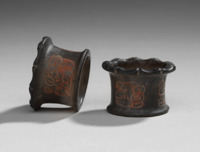 Pair of Earspools
Pair of Earspools This pair of earspools was made carved out of obsidian and cinnabar.
-
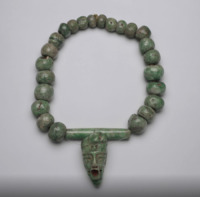 Necklace
Necklace This item is a necklace made out of jade, with a central pendant depicting a face.
-
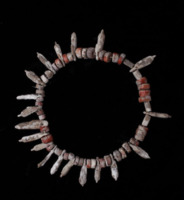 Necklace
Necklace This item is a necklace made of coral.
-
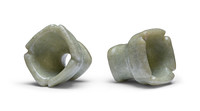 Pair of Earspools
Pair of Earspools This pair of items are earspools carved out of greenstone.
-
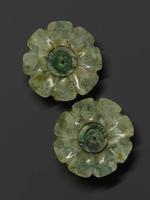 Pair of Ear Ornaments
Pair of Ear Ornaments These earflares are made of jade and were designed to resemble flowers.
-
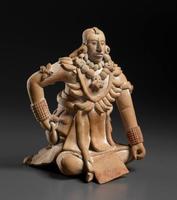 Seated Ballplayer
Seated Ballplayer The ceramic figure depicts a ballplayer wearing three skulls around his neck, alluding to the mythical story where the gods of the underworld feel threatened by how good humans become at playing the ballgame. He also wears a thick padded belt made out of cloth or leather. This was used to deflect the ball and protect their hips. An apron or skirt was wrapped around to secure it to his waist. The forearms are also protected by wristbands made of cloth.
-
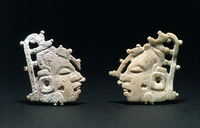 Pair of Carved Ornaments
Pair of Carved Ornaments These ornaments have been carved out of shell and depict two matching human head profiles. They would have been worn on the costumes of Maya nobles. The ornaments depict a man with an elongated cranium whose hair is decorated with beads, likely representing the maize god.
-
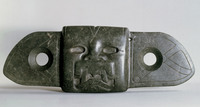 Winged Plaque
Winged Plaque This plaque depicts an Olmec deity associated with growing and harvesting maize, and the cleft on top is a sign of fertility. While this object would have been made by an Olmec, it would have been worn by the Mayas as a pendant, or a belt ornament, or even as part of a headdress. Some scholars believe that the Olmecs were the predecessors of the Mayans. Thus, wearing this represented the cycle of life.
-
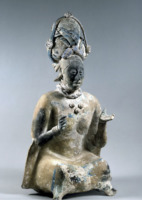 Seated Female Figurine
Seated Female Figurine This ceramic figurine represents the idea of permanent adornment through the scarification on her jaw area and cheeks. He hair is bound up with strips of cotton twisted into the hair to create an elaborate, turban-like headdress. The figure has traces of blue pigment, representing rain and nourishment.
-
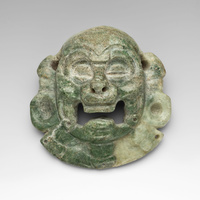 Pectoral
Pectoral This item is a pectoral made of jade. The maize god is often depicted wearing a pectoral like this one.
-
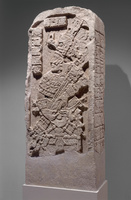 Stela
Stela This stela shows the image of a king dressed in the ritual attire and ornamentation specifically of the Maize god. The ritual would have involved bloodletting performed by the king to both summon the gods and to offer thanks to the gods for a successful 10 year period of sustenance, with good crops and rainfall. This image would have been understood to be a hybrid of a king temporarily taking the form of the deity. This would have been noticed from the ceremonial bar held by the king, as well as the spondylus shell that hangs from his belt, and his skirt and cape, which are made from a net of jade beads. The jade symbolized wealth and power, as well as water, rainfall, and nourishment. In adorning themselves with these layers of jewelry and ornamented clothing, they were also indicating to the viewer that as rulers they had the ability to provide for their people. Wearing the regalia that represents the Maize god was a reenactment of the creation of the world, in preparation for the next cycle of years.
-
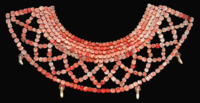 Collar
Collar This collar is made of spondylus shell and would have been worn around the neck. The shell represented the underworld, where the gods resided. In its natural state, the shell is covered with spines and is a reddish color, relating it to blood and sacrifice. One of the roles of the king (and sometimes the queen) was to perform rituals involving bloodletting as a sacrifice to the gods to ensure provisions of food and water for the coming cycle of years.
-
 Wall Panel Depicting Ix K’an Bolon (“Lady Yellow Nine”) in ritual dress
Wall Panel Depicting Ix K’an Bolon (“Lady Yellow Nine”) in ritual dress This limestone relief depicts a female member of the elite society adorned in clothing that would be worn for a ritual. The hieroglyphics identify her by name (which translates to Lady Yellow Nine) and she is wearing a large headdress made of feathers, a beaded collar, and a skirt made from tubular jade beads representing the mythical story where the maize god emerges from a turtle shell, symbolizing fertility and regeneration.
-
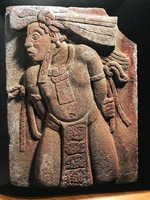 Gravestone with Captive
Gravestone with Captive This sandstone relief depicts a man who has been captured. His earflares have been replaced with paper strips, reinforcing how jewelry held a strong meaning for a Maya’s status. Being deprived of ornamentation was humiliating because it was through these objects that Mayas projected their status.
-
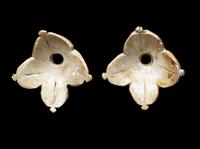 Pair of ear ornaments in flower form
Pair of ear ornaments in flower form These ear ornaments are made of seashells and are in the shape of a four-petal flower. The 4 lobes represent the cosmos, where in the beginning of time, the world consisted of 4 corners, 4 sides, and a center. Within this sacred space resided the 3 levels of the universe: the sky, the earth, the underworld.
-
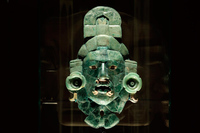 Funerary Mask of Calakmul
Funerary Mask of Calakmul This funerary mask is in the form of a mosaic using jade, obsidian, and shell. It is unknown who the mask was for, but was likely intended for a ruler. The mask has fangs that represent those of snakes; it was believed they could travel through the different levels of the cosmos. This ability represented immortality, which could be transmitted to the person wearing it. The arched portion overhead symbolized the Sacred Mountain, the mythical place of creation, where man was made from maize.
-
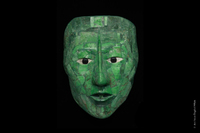 Funerary Mask of K’inich Janaab’ Pakal I
Funerary Mask of K’inich Janaab’ Pakal I This funerary mask is made of pieces of jadeite in the form of a mosaic. It depicts Pakal, a ruler of Palenque (r. 615-683 CE). Jadeite was considered highly valuable because it was difficult to obtain. Jadeite was related to death, immortality, and rebirth. Thus, using jadeite to adorn the body was a way to immortalize Pakal and secure his transition into the afterlife.
-
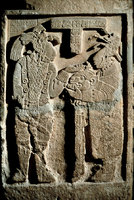 Yaxchilan Lintel 26
Yaxchilan Lintel 26 Lintel 26 represents the ritual of dressing up for war. Here, a husband and wife are shown, where the wife (Lady K’ab’al Xook) offers her husband, (Itzamnaaj B’alam II), a jaguar helmet as part of his war attire. This established a parallel with the Maize God, who was sometimes depicted as being dressed and adorned by women. Wearing a helmet or headdress with an image of a deity, which in this case was the Jaguar god, allowed a ruler to impersonate that deity and acquire the attributes of the god.
-
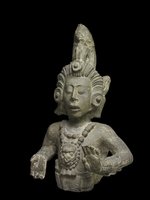 Maize god
Maize god This depiction of the maize god is wearing a headdress in the form of a stylized ear of corn while his hair is in the form of cornsilk. The maize god symbolizes fertility, nourishment, and livelihood.
-
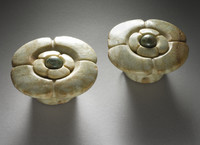 Flower-Shaped Earflares
Flower-Shaped Earflares These jadeite earflares were designed to resemble flowers.
 Pair of Earspools This pair of earspools was made carved out of obsidian and cinnabar.
Pair of Earspools This pair of earspools was made carved out of obsidian and cinnabar. Necklace This item is a necklace made out of jade, with a central pendant depicting a face.
Necklace This item is a necklace made out of jade, with a central pendant depicting a face. Necklace This item is a necklace made of coral.
Necklace This item is a necklace made of coral. Pair of Earspools This pair of items are earspools carved out of greenstone.
Pair of Earspools This pair of items are earspools carved out of greenstone. Pair of Ear Ornaments These earflares are made of jade and were designed to resemble flowers.
Pair of Ear Ornaments These earflares are made of jade and were designed to resemble flowers. Seated Ballplayer The ceramic figure depicts a ballplayer wearing three skulls around his neck, alluding to the mythical story where the gods of the underworld feel threatened by how good humans become at playing the ballgame. He also wears a thick padded belt made out of cloth or leather. This was used to deflect the ball and protect their hips. An apron or skirt was wrapped around to secure it to his waist. The forearms are also protected by wristbands made of cloth.
Seated Ballplayer The ceramic figure depicts a ballplayer wearing three skulls around his neck, alluding to the mythical story where the gods of the underworld feel threatened by how good humans become at playing the ballgame. He also wears a thick padded belt made out of cloth or leather. This was used to deflect the ball and protect their hips. An apron or skirt was wrapped around to secure it to his waist. The forearms are also protected by wristbands made of cloth. Pair of Carved Ornaments These ornaments have been carved out of shell and depict two matching human head profiles. They would have been worn on the costumes of Maya nobles. The ornaments depict a man with an elongated cranium whose hair is decorated with beads, likely representing the maize god.
Pair of Carved Ornaments These ornaments have been carved out of shell and depict two matching human head profiles. They would have been worn on the costumes of Maya nobles. The ornaments depict a man with an elongated cranium whose hair is decorated with beads, likely representing the maize god. Winged Plaque This plaque depicts an Olmec deity associated with growing and harvesting maize, and the cleft on top is a sign of fertility. While this object would have been made by an Olmec, it would have been worn by the Mayas as a pendant, or a belt ornament, or even as part of a headdress. Some scholars believe that the Olmecs were the predecessors of the Mayans. Thus, wearing this represented the cycle of life.
Winged Plaque This plaque depicts an Olmec deity associated with growing and harvesting maize, and the cleft on top is a sign of fertility. While this object would have been made by an Olmec, it would have been worn by the Mayas as a pendant, or a belt ornament, or even as part of a headdress. Some scholars believe that the Olmecs were the predecessors of the Mayans. Thus, wearing this represented the cycle of life. Seated Female Figurine This ceramic figurine represents the idea of permanent adornment through the scarification on her jaw area and cheeks. He hair is bound up with strips of cotton twisted into the hair to create an elaborate, turban-like headdress. The figure has traces of blue pigment, representing rain and nourishment.
Seated Female Figurine This ceramic figurine represents the idea of permanent adornment through the scarification on her jaw area and cheeks. He hair is bound up with strips of cotton twisted into the hair to create an elaborate, turban-like headdress. The figure has traces of blue pigment, representing rain and nourishment. Pectoral This item is a pectoral made of jade. The maize god is often depicted wearing a pectoral like this one.
Pectoral This item is a pectoral made of jade. The maize god is often depicted wearing a pectoral like this one. Stela This stela shows the image of a king dressed in the ritual attire and ornamentation specifically of the Maize god. The ritual would have involved bloodletting performed by the king to both summon the gods and to offer thanks to the gods for a successful 10 year period of sustenance, with good crops and rainfall. This image would have been understood to be a hybrid of a king temporarily taking the form of the deity. This would have been noticed from the ceremonial bar held by the king, as well as the spondylus shell that hangs from his belt, and his skirt and cape, which are made from a net of jade beads. The jade symbolized wealth and power, as well as water, rainfall, and nourishment. In adorning themselves with these layers of jewelry and ornamented clothing, they were also indicating to the viewer that as rulers they had the ability to provide for their people. Wearing the regalia that represents the Maize god was a reenactment of the creation of the world, in preparation for the next cycle of years.
Stela This stela shows the image of a king dressed in the ritual attire and ornamentation specifically of the Maize god. The ritual would have involved bloodletting performed by the king to both summon the gods and to offer thanks to the gods for a successful 10 year period of sustenance, with good crops and rainfall. This image would have been understood to be a hybrid of a king temporarily taking the form of the deity. This would have been noticed from the ceremonial bar held by the king, as well as the spondylus shell that hangs from his belt, and his skirt and cape, which are made from a net of jade beads. The jade symbolized wealth and power, as well as water, rainfall, and nourishment. In adorning themselves with these layers of jewelry and ornamented clothing, they were also indicating to the viewer that as rulers they had the ability to provide for their people. Wearing the regalia that represents the Maize god was a reenactment of the creation of the world, in preparation for the next cycle of years. Collar This collar is made of spondylus shell and would have been worn around the neck. The shell represented the underworld, where the gods resided. In its natural state, the shell is covered with spines and is a reddish color, relating it to blood and sacrifice. One of the roles of the king (and sometimes the queen) was to perform rituals involving bloodletting as a sacrifice to the gods to ensure provisions of food and water for the coming cycle of years.
Collar This collar is made of spondylus shell and would have been worn around the neck. The shell represented the underworld, where the gods resided. In its natural state, the shell is covered with spines and is a reddish color, relating it to blood and sacrifice. One of the roles of the king (and sometimes the queen) was to perform rituals involving bloodletting as a sacrifice to the gods to ensure provisions of food and water for the coming cycle of years. Wall Panel Depicting Ix K’an Bolon (“Lady Yellow Nine”) in ritual dress This limestone relief depicts a female member of the elite society adorned in clothing that would be worn for a ritual. The hieroglyphics identify her by name (which translates to Lady Yellow Nine) and she is wearing a large headdress made of feathers, a beaded collar, and a skirt made from tubular jade beads representing the mythical story where the maize god emerges from a turtle shell, symbolizing fertility and regeneration.
Wall Panel Depicting Ix K’an Bolon (“Lady Yellow Nine”) in ritual dress This limestone relief depicts a female member of the elite society adorned in clothing that would be worn for a ritual. The hieroglyphics identify her by name (which translates to Lady Yellow Nine) and she is wearing a large headdress made of feathers, a beaded collar, and a skirt made from tubular jade beads representing the mythical story where the maize god emerges from a turtle shell, symbolizing fertility and regeneration. Gravestone with Captive This sandstone relief depicts a man who has been captured. His earflares have been replaced with paper strips, reinforcing how jewelry held a strong meaning for a Maya’s status. Being deprived of ornamentation was humiliating because it was through these objects that Mayas projected their status.
Gravestone with Captive This sandstone relief depicts a man who has been captured. His earflares have been replaced with paper strips, reinforcing how jewelry held a strong meaning for a Maya’s status. Being deprived of ornamentation was humiliating because it was through these objects that Mayas projected their status. Pair of ear ornaments in flower form These ear ornaments are made of seashells and are in the shape of a four-petal flower. The 4 lobes represent the cosmos, where in the beginning of time, the world consisted of 4 corners, 4 sides, and a center. Within this sacred space resided the 3 levels of the universe: the sky, the earth, the underworld.
Pair of ear ornaments in flower form These ear ornaments are made of seashells and are in the shape of a four-petal flower. The 4 lobes represent the cosmos, where in the beginning of time, the world consisted of 4 corners, 4 sides, and a center. Within this sacred space resided the 3 levels of the universe: the sky, the earth, the underworld. Funerary Mask of Calakmul This funerary mask is in the form of a mosaic using jade, obsidian, and shell. It is unknown who the mask was for, but was likely intended for a ruler. The mask has fangs that represent those of snakes; it was believed they could travel through the different levels of the cosmos. This ability represented immortality, which could be transmitted to the person wearing it. The arched portion overhead symbolized the Sacred Mountain, the mythical place of creation, where man was made from maize.
Funerary Mask of Calakmul This funerary mask is in the form of a mosaic using jade, obsidian, and shell. It is unknown who the mask was for, but was likely intended for a ruler. The mask has fangs that represent those of snakes; it was believed they could travel through the different levels of the cosmos. This ability represented immortality, which could be transmitted to the person wearing it. The arched portion overhead symbolized the Sacred Mountain, the mythical place of creation, where man was made from maize. Funerary Mask of K’inich Janaab’ Pakal I This funerary mask is made of pieces of jadeite in the form of a mosaic. It depicts Pakal, a ruler of Palenque (r. 615-683 CE). Jadeite was considered highly valuable because it was difficult to obtain. Jadeite was related to death, immortality, and rebirth. Thus, using jadeite to adorn the body was a way to immortalize Pakal and secure his transition into the afterlife.
Funerary Mask of K’inich Janaab’ Pakal I This funerary mask is made of pieces of jadeite in the form of a mosaic. It depicts Pakal, a ruler of Palenque (r. 615-683 CE). Jadeite was considered highly valuable because it was difficult to obtain. Jadeite was related to death, immortality, and rebirth. Thus, using jadeite to adorn the body was a way to immortalize Pakal and secure his transition into the afterlife. Yaxchilan Lintel 26 Lintel 26 represents the ritual of dressing up for war. Here, a husband and wife are shown, where the wife (Lady K’ab’al Xook) offers her husband, (Itzamnaaj B’alam II), a jaguar helmet as part of his war attire. This established a parallel with the Maize God, who was sometimes depicted as being dressed and adorned by women. Wearing a helmet or headdress with an image of a deity, which in this case was the Jaguar god, allowed a ruler to impersonate that deity and acquire the attributes of the god.
Yaxchilan Lintel 26 Lintel 26 represents the ritual of dressing up for war. Here, a husband and wife are shown, where the wife (Lady K’ab’al Xook) offers her husband, (Itzamnaaj B’alam II), a jaguar helmet as part of his war attire. This established a parallel with the Maize God, who was sometimes depicted as being dressed and adorned by women. Wearing a helmet or headdress with an image of a deity, which in this case was the Jaguar god, allowed a ruler to impersonate that deity and acquire the attributes of the god. Maize god This depiction of the maize god is wearing a headdress in the form of a stylized ear of corn while his hair is in the form of cornsilk. The maize god symbolizes fertility, nourishment, and livelihood.
Maize god This depiction of the maize god is wearing a headdress in the form of a stylized ear of corn while his hair is in the form of cornsilk. The maize god symbolizes fertility, nourishment, and livelihood. Flower-Shaped Earflares These jadeite earflares were designed to resemble flowers.
Flower-Shaped Earflares These jadeite earflares were designed to resemble flowers.